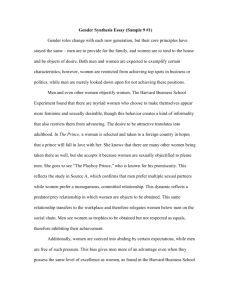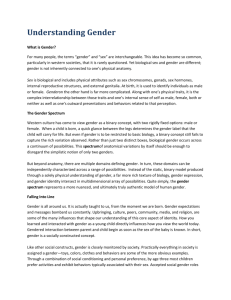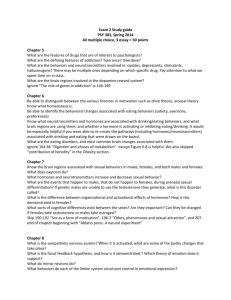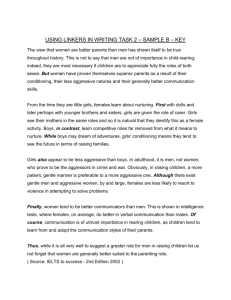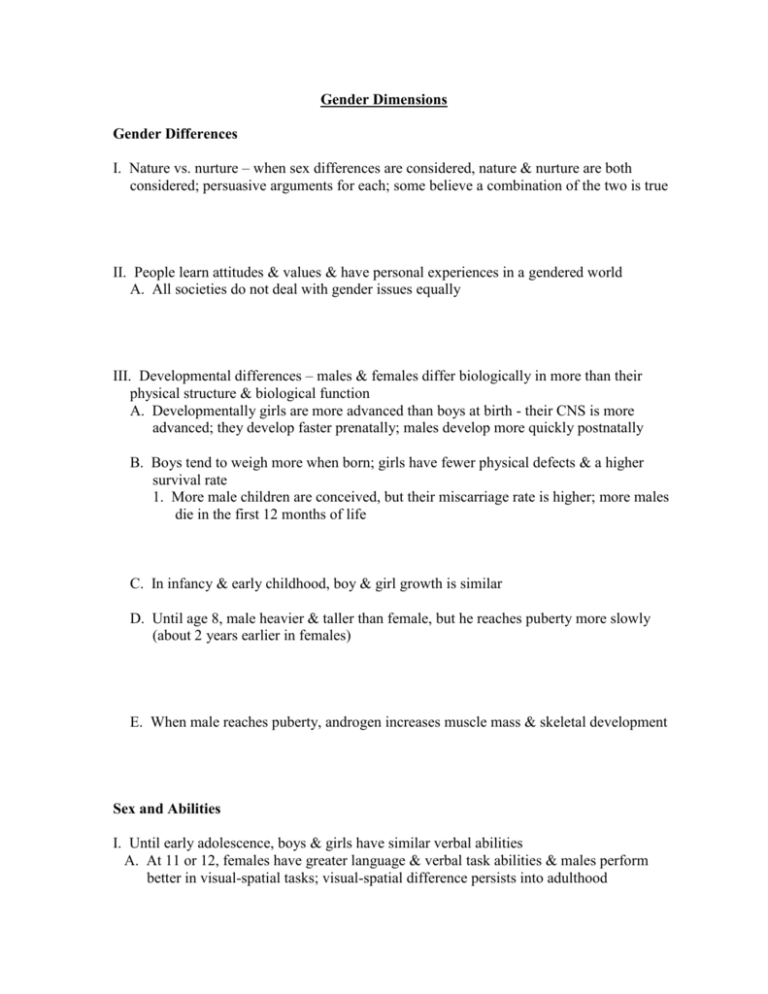
Gender Dimensions
Gender Differences
I. Nature vs. nurture – when sex differences are considered, nature & nurture are both
considered; persuasive arguments for each; some believe a combination of the two is true
II. People learn attitudes & values & have personal experiences in a gendered world
A. All societies do not deal with gender issues equally
III. Developmental differences – males & females differ biologically in more than their
physical structure & biological function
A. Developmentally girls are more advanced than boys at birth - their CNS is more
advanced; they develop faster prenatally; males develop more quickly postnatally
B. Boys tend to weigh more when born; girls have fewer physical defects & a higher
survival rate
1. More male children are conceived, but their miscarriage rate is higher; more males
die in the first 12 months of life
C. In infancy & early childhood, boy & girl growth is similar
D. Until age 8, male heavier & taller than female, but he reaches puberty more slowly
(about 2 years earlier in females)
E. When male reaches puberty, androgen increases muscle mass & skeletal development
Sex and Abilities
I. Until early adolescence, boys & girls have similar verbal abilities
A. At 11 or 12, females have greater language & verbal task abilities & males perform
better in visual-spatial tasks; visual-spatial difference persists into adulthood
B. Recently, it has become clearer that, on average, girls speak sooner than boys
1. They use more words & are more grammatically accurate
C. More highly developed math skills in men is still debated
1. Boys math skills rise rapidly at adolescence & into adulthood; girls experience
no such rapid jump
2. Historically, math was perceived as a masculine area of study in which girls
were not expected or encouraged to excel
D. On average, men seem to excel at higher mathematical problems (not arithmetic)
E. In tests of 12th graders' cognitive abilities, boys outnumber girls 5 to 4 in both the
top & bottom 10% with girls bunched in the middle; other tests similar
II. This does not mean that biology is destiny when it comes to these abilities – there are
cultural explanations for these differences
Sex & Aggression
I. Maccoby & Jacklin (1974) - Beginning at preschool age, boys are more aggressive, both
physically & verbally than girls
A. Said male aggression is aimed at other males rather than females – rape is obvious
exception but it wasn't included in study
B. Boys & men stay aggressive into their college years, but with maturity it wanes
C. Hyde (1984) – reported gender differences in aggression as well
D. Studies in Japan, Philippines, Mexico, Kenya, India, New England – boys more
aggressive in each culture; nurturing is female counterpart of male aggression
II. Domestic violence in US is major problem – most forms of violence have dropped in
recent years but violence by males against female intimate/acquaintance have stayed
constant or rose
III. Tavris (2000) – reported about female aggression; many recent authors have written
about hidden & formerly secret female aggressiveness
A. She said girls are not sweeter than boys; they are just as bad, sexual & aggressive —
maybe even meaner, given the ruthless & sneaky ways they control each other
B. Culture refuses girls access to open conflict so their aggression is nonphysical, indirect
& covert
C. Boys resort to physical aggressiveness, girls to relational aggression
IV. Anger & aggression are learned behaviors & characteristic of humans
Sex & Health
I. Differences in male & female health attitudes & behavior
A. Taking action to prevent health problems is more common among women than men
B. Women report average of 13.5 days/year when illness reduced usual activity, men
only 6.7 days
II. Minority of patients prefer medical care provider of particular sex but males show less
preference than females
A. Women have a clear female preference in general practice & gynecology due to
intimate nature of clinical intervention
III. Females are much more likely than males to get prescriptions for antibiotics – don't
know if it's because doctors give females more prescriptions or because they ask for more
IV. Sex-role identity is related to individual's decision whether to engage in behaviors that
affect health
A. College males with androgynous gender-role identity (scored above median on psych
tests for both masculinity & femininity)
B. Most health insurance plans cover prescription drugs, but many exclude coverage for
prescription contraceptives
V. International - power imbalance increases HIV risk
A. Many societies have culture of silence surrounding sexuality that says good women are
expected to be ignorant about sexual behavior & passive in sexual interactions
1. Makes it hard for women to be aware about HIV risk reduction & if aware to be
proactive in negotiating safer sexual activity
B. In cultures where virginity is highly valued, some young women practice alternative
sexual behaviors like anal intercourse to preserve their virginity
C. Use of barrier contraceptive methods as safer sexual activity options can be dilemma
in societies where motherhood is feminine ideal
VI. Some people think health care delivery & research benefit men at expense of women
A. Heart disease studied more in men & women have been excluded in major national
clinical studies
B. Others feel that women have benefited from medical research
VII. Sex differences related to sexual satisfaction & health – males & females both rate
sexual satisfaction as very important to quality of life
A. If there are sexual problems, 57% of women thought that women would be blamed
most often; only 37%of men said that
B. Males & females show similar degrees of physical & emotional satisfaction with their
sexual partnerships
C. It has been proposed that gender-role expectations may relate to the expression of
depressive symptoms
D. Kluger (2003) – reported twice as many women as men suffer from depression &
twice as many men suffer from alcoholism
E. Recent decades – found that men with history of heart disease were 2 – 4 times more
likely than females to die later of sudden cardiac death
F. Men lead women in 12 of the 15 causes of death in US & die an average of 5.4 years
earlier than women
1. 1920 – difference was just 2 years; some of gender gap may be due to biological
differences, many now believe that much of gap is due to inattention to men's health
G. Gender twist involving nutrition – supermarket aisles are filling up with nutrient-rich,
female-friendly treats
1. Luna nutrition bar decorated with silhouetted dancing girls & packed with
ingredients that women are supposed to need
Sex & Dating
I. When it comes to dating, females assume that many men will try to deceive them, but
males do not seem to feel that females will deceive them
A. Females are especially sensitive to possibility of deception if males are trying to
persuade them to participate in sexual behavior
II. Effect of sex on emotional reactions to termination of romantic relationship among
college students
A. Women tend to feel more joy & relief than men
B. Men & women are equally likely to blame themselves for break-ups
III. Frequency of sexual behavior & number of partners – common sense suggests that
heterosexual males & females would have equal numbers of sexual partners
A. But males consistently report more partners than females
B. Some research on sexual satisfaction has assumed that coital orgasm was goal for
both partners
C. Power is fundamental to both sexuality & gender – typically men have been more
powerful in relationships
D. Nature of intimacy can also be factor related to male-female relationships
IV. Interesting development in dating among some successful women is the lesser
boyfriend
A. Some celebrity women choose less successful beaus – modern woman often works
& is financially independent; some feel this to be true female empowerment
Other Gender Issues
I. What do men & women talk about when they get together with their closest friends? –
Segell (1989)
A. Men – work issues, sports, goals for the future
B. Women – children, personal problems & self doubts, work issues
II. What disturbs men & women? – Goleman (1998)
A. Qualities that disturb women most about men
B. Qualities that disturb men most about women
III. Schwartz (1998) – most important fact about today's men & women is how similar they
have become; similarity introduces new challenges
IV. Father's role at home is under negotiation
A. When men take an active role in the details of running a home & raising children:
B. Increasing men's involvement in family work has the potential to increase women's
public status & reduce men's propensity for violence
V. Helen Fisher (2001) – other gender differences
A. Men usually want to cut straight to the point; they do not like to get distracted by side
issues
B. Women have a more contextual view of the world & see issues as part of a larger
whole
Gender and the Workplace
I. Men & women may even have different approaches to situations in which they are going
to be evaluated, such as for job performance
II. Employment history may be factor in gender-role attitudes
A. Employed women – less traditional in their views of women's appropriate roles than
women who are not employed
III. Christie Hefner – gender is a factor in leadership styles, but there are as many
leadership differences among women as there are differences between men & women
IV. One study showed that women scored higher on orientation to production & getting
results; men scored higher on strategic planning & organizational vision
A. Women operate with more energy, intensity & emotional expression
B. Men were seen as more low-key & quiet through the control of emotional expression
V. Many people assume that women would rather work with & be supervised by other
women, but some studies suggest that women can be each other's worst enemies on the
job
A. Women often betray & undermine one another
B. They damage other women's career aspirations
C. They often fail to support other women – even actively undermining their authority
& credibility
VI. Since >50% of the women with babies <1 year old are in the workforce, increasing
numbers of them want to breastfeed their infants
A. More companies are setting up private rooms & work schedules so mothers can
pump their breast milk
B. Some provide private room, hospital-grade pump, a carrying case for discreet
transport of pumping paraphernalia & expressed milk plus bottles & refrigerator
access
C. 2001 – Illinois became fourth state to enact legislation protecting a woman's right to
express milk at work
VII. Relationship between men's & women's salaries – 2000 census says nearly 4.6 million
men & 925,000 women were paid $100,000mor more
A. Median earnings for men - $30,132; for women - $18,996
B. Salary differences do not necessarily indicate that wage discrimination is rampant
C. Some men say work atmosphere turns very chilly when they seek time off to care for
infants or take kids to doctor's appointments
D. Barriers to women's success in workplace are being removed
1. 1900 – most of 21% of white women who were employed were confined mostly
to textile & garment factories
2. Now – many women wield power in small business; in US, nearly as many
people work for women-owned businesses as work for Fortune 500 companies
worldwide
3. Today – 49% of professional, managerial & administrative workforce is women;
86% of all Fortune 500 companies have at least one woman board member
Sex and Advertising
I. Characters in MTV commercials & music videos are often stereotyped
A. Signorielli et al. (1994) – found that female characters appeared less frequently, had
more beautiful bodies, were more physically attractive& wore more sexy/skimpy
clothing
II. Sex roles have been depicted in TV commercials for many years – authoritative male
voice is still used in >90% of commercials
A. Since 1950s, there has been a change in the images of women in commercials but not
in men's images
B. In same time, images of men have changed little – there has been slight increase in
images of men parenting & a decrease in images of men doing housework
III. Sex bias in medical advertising may be one factor contributing to different treatment of
men & women by physicians
A. More male than female patients were seen in medical advertising
B. Male facial expressions were likely to be serious or neutral; female facial expressions
were likely to be judged pleasant
IV. Have there been changes in masculine & feminine traits over time? – analysis of 59
studies done since 1973
V. Male & female behavior around us merges with cultural beliefs/values to form our
personal views of gender – gender is an arbitrary, ever-changing socially constructed set
of attributes
Gender Identity, Roles & Stereotypes
I. Social influences go to work on baby to form baby's gender identity & mold his/her
future role as soon as it is born
A. Each society has set of rules for how males & females should behave
B. Psychologists have tried to explain how children do it in many different ways &
different levels (psychoanalytical, social-learning, cognitive-developmental, genderschema)
II. Psychoanalytical theory – explained by Sigmund Freud; appropriate gender typing means
that boys grow to identify with their fathers & girls with their mother
A. Identification completed as children resolve Oedipus complex (Electra complex in
girls); from 3 – 5, children supposedly develop incestuous wishes for parent of other
gender
B. Today the psychoanalytical theory of gender role development is not widely accepted
III. Social-learning theory – development of gender-typed behavior is explained in terms of
processes such as observational learning, identification & socialization
IV. Cognitive-developmental theory – children form concepts about gender & then make
their behavior conform to their gender concepts; called gender typing
A. By ~7 or 8, gender constancy develops in most children
V. Gender schema theory – indicates that children develop a grouping of mental
representations about male & female personality traits, physical qualities & behaviors
A. Once they develop gender schema, they begin to judge themselves according to traits
considered relevant to their genders
B. By doing this, they blend their developing self-concepts with the gender schema of
their culture
Gender Identity
I. Gender includes biological component + biological, social - cultural norms & gender
identity (one's self-image as female or male); attachment one has to one's role
A. Societal & cultural factors are thought to exert more influence on gender identity than
biological component
B. Masculinity & femininity are not innate or instinctive
1. Masculinity or femininity of gender identity needs healthy human brain in which
to take root
2. However, developing brain is shaped by environment in which it grows & from
which it takes its mental nourishment – Money, 1988
C. Since each society defines its roles for males & females & perpetuates behaviors
through gender-role socialization
II. Gender roles differ significantly from society to society
A. Atapesh women do all the routine carrying since their heads are thought to be
stronger; men share the care of the children
B. Both Samoan men & women do heavy gardening, fishing, cooking & handiwork
C. Societies in various parts of world have directed socialization of children so that
(intentionally or unintentionally) women will be kept in their place
D. Many societies discourage any deviation from prescribed gender roles; others are now
working toward flexibility & individualism in wide variety of behaviors
III. Stereotyping – expectation that people will exhibit certain characteristics and/or
behaviors dictated by customs & traditions of society
A. Expecting individuals to behave in particular ways because they are males or females
is called gender-role stereotyping
B. There are still many rigid, unyielding traditional attitudes about gender-role behaviors
that make it hard for people to express themselves & for society to implement change
C. Stereotypical images of people do not take into account individual differences
D. Until recently, stereotypical woman/wife in our society was passive, quiet &
concerned primarily with home, husband & children
E. Danger of such stereotypes is that people take them seriously & act on them, turning
blind eye to qualities, capabilities & interests of individuals – often even deny their
own
1. People often believe that those who deviate from stereotypes are not as good as
those who conform to them
F. Assumptions behind such stereotyped behavior are being challenged now & laws are
also being changed but popular assumptions, attitudes slow to change & still passed
on
IV. Teaching gender roles & stereotypes – taught throughout life cycle
A. Parents have greatest effect, especially when children are very young
1. Very early on, parents reinforce behaviors deemed acceptable to child's gender
with remarks, smiles & nods
B. Influence of schools – school personnel pass on social stereotypes
1. Teachers can exhibit biases in how they treat & evaluate their students
2. Amer. Assn. of Univ. Women study (Kantrowitz, 1992) – girls & boys get different
treatment in classroom
3. Sadker & Sadker (1985) – teachers praise boys more than girls, give boys more
academic help & more likely to accept boys comments during class discussions &
4. Teachers who believe in stereotypes may expect one sex to excel more in certain
subjects, encourage one sex more or favor one in terms of attention and/or extra
help
5. School materials can influence gender-role stereotyping – trend in preschool
picture books is to show greater gender equality
6. Some claim bias still exists in achievement tests – language often refers t males &
their environments
7. Even in college, teachers need to be sensitive to influence: Crawford & MacLeod
(1990) – found that males did seem to participate more but ……..
C. Influence of parents – at birth, interaction with parents starts; it differs with child
gender; many social scientists think parents very important in sex role establishment
1. Traditionally, girl seen as fragile, need protection & have needs revolving around
personal appearance/development; boy seen as tough, physically active,
unemotional
2. Parents are trying to prevent teaching stereotypes but can be hard to do – may act
differently to child based on gender even if they don't intend to
3. What children see at home re: sex roles has influence & sends messages – if both
parents work outside home as managers, home duty redistribution may not happen
4. Some argue it possible to raise gender-neutral children & that it would result in
more positive self-esteem – but it is a controversial question
D. Influence of peers – early on, children choose playmates of their own sex most of
time; this segregation continues into school years
1. Segregation helps to contribute to sex typing in play activities that help prepare
children for adult roles
Gender Identity Difficulty – Transsexualism
I. Gender dysphoria – people believe they are trapped in body of wrong sex; sometimes
synonomous with transsexual
A. Transsexual also can refer to people who want to have or have had their genitals
surgically altered to conform to their gender identity
B. Transsexualism, a gender orientation, should not be confused with homosexuality, a
sexual orientation ; some are heterosexuals & some are homosexuals
II. Estimates of number of transsexuals vary widely – some say it ranges from 1 in 100,000
to 1 in 37,000 for males & 1 in 400,000 to 1 in 100,000 in females; ~25,000 in US
A. In 1960s & 1970s, when surgical procedures for change in genitals were developed,
~3 of every 4 who wanted to change were men
III. No clear understanding of either causes or nature of transsexualism
A. Some believe causes relate to early parent-child relationships related to gender roles
of mothers & fathers & the ways that parents treated a child
B. Others focus on hormonal imbalances that influenced the brain during prenatal
development, but no one knows for sure
IV. Gender-Reassignment Surgery – controversial; psychotherapy has not been very useful
for most transsexuals
A. Since surgery is irreversible, professionals usually require that the transsexual live
publicly as a member of the other sex for a year before surgery
B. Lifetime of hormonal treatment is also necessary
1. Male-to-female transsexuals take estrogen –
2. Female-to-male transsexuals take androgens –
C. Not possible to construct internal genital organs or gonads so the surgery is mostly
cosmetic
1. Male —> female surgery is usually more successful since it is easier to construct
vagina than working penis; vast majority of those who get surgery are happy with
it
D. What is done with intersex infants (born with ambiguous or mixed genitalia &
chromosomal structures)?
Influence of Sex Stereotypes on Sexuality
I. Traditional definitions of gender role behaviors are confining, emphasizing conventional
conformity to long-existing norms
A. Males socialized toward initiating, aggressive & directive behaviors; females toward
receiving, passive & compliant behaviors; men initiate, females passively receptive
B. Pressure to conform to socialization has provoked anxieties in both sexes; just now
being recognized
II. Implications for a person's social abilities
A. Quackenbush (1990) – found androgynous males reported greatest degree of comfort
& confidence in dating & social-sexual situations
B. Each sex needs to be able to express feelings previously defined as either masculine
or feminine; both sexes need to be directive & sensitive in order to function
effectively
C. Many men & women still differ in expectations for interpersonal relationships
D. Sex roles may also influence marriage rates among women
E. Mixed feelings about what they really feel & what society tells them they are
supposed to feel can confuse both sexes
III. Gender differences related to sexual behavior & expectations have been found among
adolescents in grades 8 – 10
A. Boys initiate sexual intercourse earlier than girls, but by grade 10 the girls' rates of
sexual intercourse surpassed the boys'
B. Girls reported higher intention to use condoms & also felt more pressure than boys to
engage in sexual intercourse
IV. Related to communication, some ways to close the gender gap
A. Get honest before you get angry; something deeper than dry cleaning is bothering you
B. Establish systems for sharing chores & child care
C. Negotiate the division of labor & the division of love
D. Do not get locked into your role: try swapping responsibilities on occasion
E. Express your emotional needs & expectations & really listen to your partner
F. Review the cultural messages of your childhood to help you understand the conflicts
inherent in your new roles
G. Give each other time to change: do not monitor or criticize
H. Accept your differences & applaud each other's strengths
I. Protect your intimate time together
V. Men & women seem to be different in reactions to their first sexual intercourse
experience
A. Women – more likely to report their first experience left them feeling less pleasure, ,
satisfaction & excitement than men were
B. Women felt more sadness, guilt, nervousness, tension, embarrassment & fear
VI. It is now thought that similarities between men & women in struggle for intimacy far
outweigh the differences
VII. In terms of human sexual expression, both partners need freedom to be self-disclosing,
intimate & communicative
Possibilities of Androgyny
I. Androgynous person has a combination of masculine & feminine characteristics
A. Androgynous male might be nuturing in addition to providing; androgynous female
might be assertive as well as soft-spoken
B. Idea of androgyny can serve as means of doing away with gender-role stereotyping
1. Many people think they must conform absolutely to society's notions of maleness
& femaleness, especially in ways they acknowledge/express their feelings
2. In conforming, they lose the opportunity to express themselves as individuals
II. Concept of androgyny has been around a long time
A. Sandra Bem (1975) – stereotypical roles are restrictive & unhealthy; described
androgynous people as flexible & healthy
B. Developed Bem Sex Role Inventory & then tested evaluees in different situations
1. Men who described themselves as masculine were not comfortable in feminine
activities
C. Not all studies support the concept of androgyny
1. Androgynous workers reported more satisfaction with their jobs than other
workers but also had more job-related stress
2. Another study reported androgynous males to be less emotionally healthy than
masculine males,
D. Sex role stereotypes can be burdensome especially to those who do not accept them
whether the individual is male or female
E. Stereotypes of masculinity can burden men
F. Androgyny & leadership
1. Some studies show that women lead in interpersonally oriented style & men in
task-oriented style; other studies do not show these differences
G. Male supervisors in large government agency indicated they would not treat female
employees differently from male employees
1. Male employees reported that males were treated better than female employees
H. Androgyny does not work as well in families
1. Parental androgyny is not feasible because of inherent biological differences that
have significance for parenting



